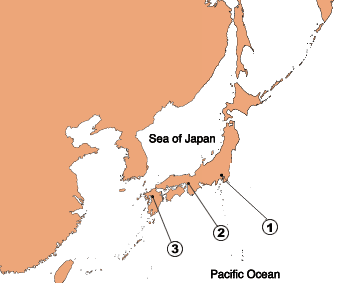| Web Japan > NIPPONIA No.29 > Japan Travelogue |
|
|
|
NIPPONIA No.29 June 15, 2004
|
|
Japan Travelogue |
 |
(1)Tokyo
(2)Osaka
(3)Nagasaki |
|
Nagasaki is on northwestern Kyushu, in central Nagasaki Prefecture. The city spreads out around the long, narrow Nagasaki Bay, and is separated from other parts of Kyushu by the surrounding mountains. In medieval times, after the port was opened up for international trading, the cultures of foreign lands began exerting their own influence, and this remains in some of the architecture and cultural life of the city. Tourists keep coming to enjoy the unique atmosphere.
In 1570, work began under the local feudal lord, Omura Sumitada, to develop the port into an international trading center open to foreign vessels. This decision came about because guns and Christianity were entering from the West. In 1641, the Edo Shogunate shut Japan off from foreign commerce, beginning a period of isolation that lasted for more than 200 years, but there was one exception—Nagasaki was allowed to act as the nation's only window to the outside world. Japanese trade with the Netherlands was conducted from Dejima, an island on reclaimed land in Nagasaki Bay. In the old days, the Dutch merchants could only operate on the small island. Today, the area is part of the city center, and nothing remains of their activities there.
In the mid-1800s, after Japan opened up to the outside world, people came from places like Britain, Russia and China to establish businesses and homes. They settled in the area south of Dejima. Today, on a small hill in the southernmost part of the former settlement, there is an outdoor museum called Glover Garden. It features nine houses that were built and lived in years ago by foreign residents. The houses were relocated to this place and repaired to recreate an old Western settlement. The Former Glover Residence here was built in the colonial style by a British trader in 1859, and is reputed to be the oldest Western-style wooden building in Japan. From the garden of the residence you can see the entire harbor. How would the original owner, Mr. Glover, living in this foreign land, have felt as he watched the ships entering and leaving the port?
Oura Church stands next to Glover Garden. Constructed in 1864, it is Japan's oldest wooden church built in the Gothic style. Its stained glass windows are most impressive, and the church has been designated as a National Treasure.
Oranda Zaka ("Holland Slope") is a stone-paved walkway with a view of Western buildings. The steeply sloped walkway is to the north of Oura church, and was used by parishioners attending religious services. If you walk down the hill, you will soon come to Shin Chuka-gai (New Chinatown).
Trade and business with China were once conducted from Shin Chuka-gai. Here you will see many Chinese restaurants and stores, all crammed into a district that measures only about 200 meters square. Nagasaki's most famous contribution to cuisine, champon, was developed here about 100 years ago in a Chinese restaurant called Shikairo. The recipe is based on a Chinese variety of noodle soup, and packs plenty of nutrition with a mixture of ingredients, often shrimp, squid, bean sprouts and cabbage. Because many ingredients are mixed together, the name champon ended up meaning "hodgepodge" in Japanese, and the word is now used throughout the country.
The restaurant's general manager, Chin Masatsugu, says, "Nagasaki developed a culture of its own by absorbing the cultures of other countries. Champon is based on a Chinese recipe, but the ingredients are ones easily obtained here, so it evolved into a unique dish."
Nagasaki is geographically quite close to China, and in the latter part of the 17th century, about 10,000 of the city's 60,000 people were Chinese. Some aspects of Chinese culture remain, such as temples founded by Chinese residents long ago. The most notable examples are Sofuku-ji, east of Shin Chuka-gai, and Kofuku-ji, to the north. We can imagine the people praying here years ago, thinking of their native land. There is another structure, a stone bridge constructed under the guidance of a Chinese monk. It is called Megane-bashi ("Eyeglasses Bridge"), because the two arches reflected in the river look like a pair of glasses.
In Nagasaki, there are many places influenced by the West and China, creating a champon of cultural attributes.
One unforgettable fact about Nagasaki is the atomic bombing that brought disaster to this city, following Hiroshima. In an instant, the bomb that fell on the northern part of Nagasaki on August 9, 1945 turned the area into a sea of death, taking about 75,000 lives. Today, the land at the epicenter is a Peace Park. So much has changed that it is hard to believe such a tragedy could have happened. A ceremony is held there every year on the anniversary, to commemorate the victims.
Nagasaki, a city that benefited from the influence of foreign cultures, has overcome the tragedy of war and continues to exert its influence for world peace.
|
|
||||||||
|
||||||||
|